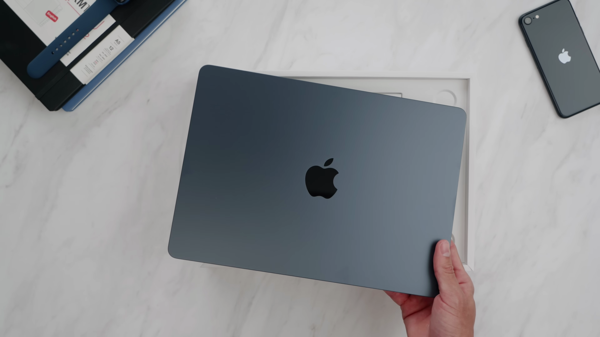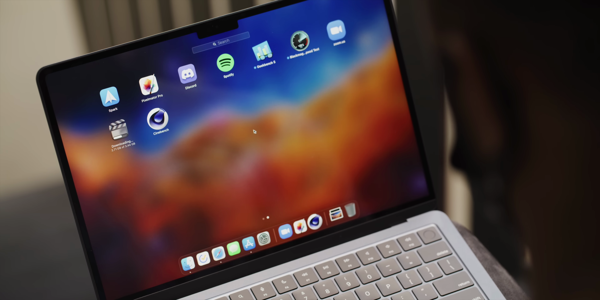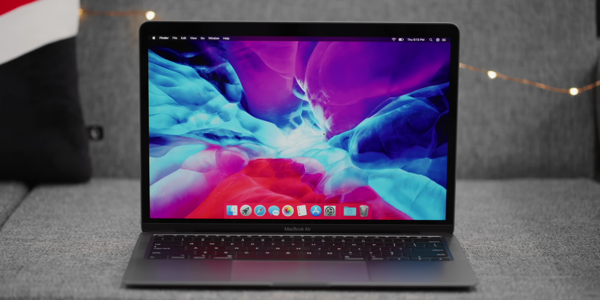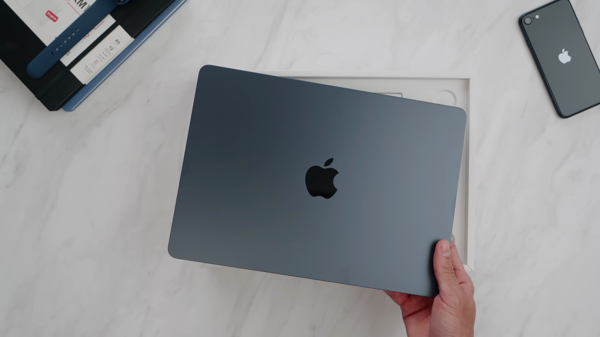Note: As an Amazon Associate we earn from qualifying purchases.
My experience with the Apple Macbook Air M2 (2023)
Introduction
I recently made the switch to a MacBook Air M2, transitioning from a Windows-dominated workspace. The change, prompted by the MacBook’s reputation for performance and design, was quite interesting. I value efficiency and ease of use - which has Apple has quite a good reputation on. With my old HP laptop as a comparative backdrop, I was eager to see if this new machine could live up to its promises and transform my workflow.
Prices
Check prices of the Apple Macbook Air M2 on:
Photos
Click on photos to enlarge them:
First Impressions and Design Aesthetics

My first encounter with the MacBook Air M2 took me by surprise; pivoting from my longstanding reliance on Windows-based systems felt like a leap into the unknown. Yet, what struck me immediately was the unboxing experience—the device isn’t just a piece of technology, it’s a statement. Fresh out of the packaging, it was immaculate, no blemishes or signs of wear that I half-expected from something labeled “open box.” The midnight color option is a particular highlight, although I’ll admit it seems prone to scratches, nudging me toward getting a protective cover.
The design is slender, lightweight, and—for lack of a better word—elegant. Holding it, you can’t help but notice the sturdiness despite its thin profile. The 15-inch screen is a feast for the eyes, rendering colors vividly and text with crisp sharpness. Being used to the heftier laptops of yesteryear, I was pleasantly surprised by how portable it felt, negating any initial worries I had about the larger screen compromising its portability.
Transitioning from HP laptops and Android devices, the MacBook Air demands a brief adjustment period. The macOS environment is streamlined, yes, but it’s starkly different from the Windows UI, introducing a learning curve that’s both intriguing and slightly daunting. Though, once acclimated, the intuitive gestures and navigation feel almost second nature. The magnetic charging port spares you the wrath of bent adapters, and I can’t get enough of the biometric login; it adds convenience without sacrificing security.
It’s also worth noting the ports—or the lack thereof. With only two USB-C ports and a MagSafe (plus a lone headphone jack that feels more vestigial by the day), connectivity could be an issue without investing in additional dongles. It’s a restraint that encapsulates Apple’s push for minimalism, perhaps to a fault for users who rely on legacy peripherals.
Despite its streamlined design, the MacBook feels like it punches above its weight considering performance, which is covered elsewhere in this article. However, diving into hardware specifics, the M2 chip is touted as a powerful upgrade to its predecessor, the M1, which warrants attention for anyone eyeing a new MacBook purchase. Substantial claims have been made regarding its speed and efficiency—something that future users, myself included, are eager to test out thoroughly.
From a design standpoint, the MacBook Air M2 nails the aesthetics and the initial feel in the hand. It has its drawbacks, but these seem negligible when stacked against the overall user experience promised by Apple. It’s a product that, at first blush, seems to understand its audience—those seeking power in a streamlined and aesthetically pleasing package.
Despite my concerns about durability and the adaptability of my workflow to the new system, the transition has been met with a surprising level of enthusiasm. The expanded real estate of the 15” model combined with the machine’s lightweight build are compelling arguments in its favor. As I continue this journey, the MacBook Air M2 seems set to consolidate its position not just as a status symbol, but as a potent tool for a range of tasks, evident from other user testimonies that echo similar sentiments. Whether it will live up to the full spectrum of my computing needs remains to be seen, but as impressions go, it’s certainly made a mark.
Performance and User Experience

Performance wise, the MacBook Air M2 has been nothing short of impressive. It boots up fast—shockingly so, compared to my old clunker of a laptop that had become reminiscent of a 90s dial-up connection. I can have multiple tabs open, stream content, bounce between creative software like Final Cut Pro, and it doesn’t miss a beat. The response time is snappy, and that’s critical for me as someone who values efficiency.
The upgrade from a MacBook Pro 2017 model was well-justified. The Air handles photo editing like a champ, thanks largely to the M2 chip. You can check out details on this on Apple’s official page. And while I hesitated over the loss of additional ports, owning a couple of USB-C adaptors has mitigated that issue. It’s a trade-off but for the gain in performance, I’ve found it acceptable.
Apart from performance, user experience is also largely positive. The 15-inch screen serves as a nice sweet spot between portability and comfort for extended work sessions. It’s larger than the 13” models I’ve been tethered to in the past, making everything from editing to reading more enjoyable. The keyboard feels crisp, responsive, and notably less prone to the crumb-induced chaos that seemed to plague older models.
One of the smaller, yet appreciated features is the biometric login. It streamlines accessing my device, giving it a personal and secure touch. As someone who values security, this is a notable perk.
Migrating from Windows to Mac OS was less of a hurdle than anticipated. I commend Apple for the intuitiveness of their operating system. There’s a learning curve, sure, but it’s a manageable one even for those not tech-savvy—something users have mentioned.
Now, for the drawbacks. The Air, while light, has a heftier feel when opting for the larger screen. This does affect portability slightly—something to bear in mind for those always on the go. The scratch vulnerability of the Midnight color variant had me purchasing a cover almost immediately; a necessity if you care about aesthetics.
On one unfortunate occasion, I encountered a security breach message. It raised concerns about system integrity. I’ve learned this is relatively rare, but it prompted me to have closer interactions with Apple’s support, which, thankfully, was top-notch.
Cost is always a factor with Apple products. This MacBook Air M2 wasn’t cheap, and while there are budget-friendly alternatives, they often lack the polish and reliability Apple offers. You’re paying for quality—I get that, and in the long run, I see this as a cost-effective investment. Purchasing through platforms like Amazon adds convenience and potential savings.
In terms of longevity, I’m optimistic. My preceding MacBook Pro survived almost 5 years, and if this Air follows suit, I’ll be satisfied. I’ve seen enough in this model to believe that it’s a durable piece of tech, aligning with the consensus of longevity in macOS devices. For anyone curious about the newest macOS hardware and their potential for lifespan, my thoughts on the M3 iMac (2023) delve into the latest Apple innovations.
Overall, I’d say my experience with the MacBook Air M2 has largely validated the buzz. It’s a reliable workhorse—sleek and fast—with a few compromises that are overshadowed by the laptop’s overall performance and quality. For those considering an upgrade, you might find my take on whether 8GB RAM is enough for the new M3 MacBook Pro (2023) insightful as well. It’s a sign of where Apple is heading—balancing elegance with power—and I’m here for the journey.
Compatibility and Integration within the Apple Ecosystem

In my time with the MacBook Air M2, the standout feature has decidedly been its compatibility and integration within the broader Apple ecosystem. Having previously used various devices from Android and Windows, I can certainly appreciate the seamlessness with which Apple products communicate with one another.
The handoff capability is impressive. For instance, starting an email on my iPhone and finishing it on the MacBook Air is practically effortless. Similarly, the Universal Clipboard makes it feel almost magical to copy text on one device and paste it on another. I’d always read about these features on forums like Reddit and Hackernews, but experiencing them firsthand is something else entirely.
However, it’s not all perfect; the limited port selection has been a developmental pain point. With only two USB-C ports, I’ve had to invest in adapters and hubs to connect some of my non-Apple peripherals, which wasn’t necessary with my previous HP laptops. While this is a common talking point on tech threads, one cannot overlook the benefit of MagSafe charging – simple, yet significantly reduces wear on the ports.
Continuity features like AirDrop and Sidecar facilitate a workflow that really utilizes the full suite of my devices. Using my iPad as a secondary display was surprisingly intuitive, and transferring files with AirDrop has negated the need for flash drives or cumbersome email attachments. It’s worth noting that similar features in the Windows ecosystem, such as Your Phone, just don’t compare in performance and ease of use, based on my personal experience.
The integration extends to software too. iCloud keeps my documents and photos in sync without needing to second-guess where my files are stored. The iCloud Drive is accessible across all my devices, which isn’t something I could say for other cloud services I’ve used in the past. While one might argue that you get similar functionalities with services like Google Drive, the native integration in macOS feels more polished and reliable.
One cannot ignore the privacy and security aspects either, which Apple heavily advertises. The fact that I didn’t have to clutter my MacBook with third-party antivirus software, as I did with my Windows machines, is a breath of fresh air.
Coming to cost, there is a premium. A MacBook Air isn’t the cheapest option, but when evaluating the longevity and overall experience, I find it justifiable. Based on my interactions on tech forums, many users report longer lifespans for their MacBooks compared to Windows-based systems.
To conclude, I’m leaning towards a positive outlook on my MacBook Air M2 experience, especially when it comes to how well it plays with other Apple products. The drawbacks of the Apple ecosystem—like the need for dongles and the higher upfront cost—are real, but they’re eclipsed by the cohesive and frictionless user experience. Certainly, the broader Apple ecosystem has its quirks, but once fully immersed, it’s hard to envision going back to a more fragmented setup.




